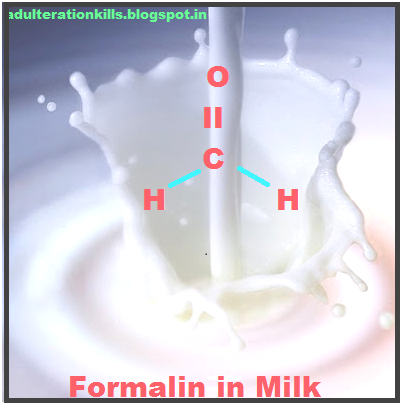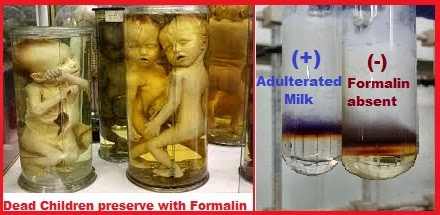Adulteration In Milk & Milk Products - Chapter - 5
- Synthetic milk has a bitter after taste, gives a soapy feeling on rubbing between the fingers and turns yellowish on heating.
- The milk can easily be tested by Urease strips (available in the Medical stores) because Synthetic milk is devoid of protein.
 |
| Adulteration Check kit for Urea in Milk |
Source / Purpose of Adulteration:
Urea is used as synthetic protein, easily available on Agricultural store as a fertilizer/protein
is calculated by % of Nitrogen present in milk, due to the presence of Nitrogen of Urea, on
analysis milk given higher value than actual value, that’s why milk supplier mix urea.
Loss/Health Effect:
Failure of Kidney, Damage Heart and Liver.
5.2. Detection of Formalin in Milk:
Urea is used as synthetic protein, easily available on Agricultural store as a fertilizer/protein
is calculated by % of Nitrogen present in milk, due to the presence of Nitrogen of Urea, on
analysis milk given higher value than actual value, that’s why milk supplier mix urea.
Loss/Health Effect:
Failure of Kidney, Damage Heart and Liver.
5.2. Detection of Formalin in Milk:
 |
| Formalin in Milk |
- Take 10 ml of milk in a tests tube and add 5 ml of concentrated sulphuric acid from the sides of the wall without shaking.
- If a violet or blue ring appears at the intersection of two layers then it shows presence of formalin.
Adulterant / Purpose of Adulteration:
Formalin chemical available at chemical supplier for the purpose of preservation of dead materials/ Formalin enhances the life of milk and thus is added for preservation purpose.
Formalin chemical available at chemical supplier for the purpose of preservation of dead materials/ Formalin enhances the life of milk and thus is added for preservation purpose.
Loss/Health Effect: Irritation and cancer.
 |
| Left- Preservation, Right- Analysis of Formalin |
Detection of Vegetable oil (Vanaspati) in Milk #
- Take 3 ml of milk in a test tube.
- Add 10 drops of hydrochloric acid. Mix up one teaspoonful of sugar.
- After 5 minutes, examine the mixture.
- The red colouration indicates the presence of Vegetable oil in the milk.
Loss/Health Effect: Monetary loss, elevate cholestrol, diabetes and coronary ailments.
Source/ Purpose of Adulteration:Vegetable oil / Decrease the Manufacturing cost and increase fat %.
_______________________________________________
_______________________________________________
Detection of Urea in Milk #
- Take a full teaspoon of milk in a test tube.
- Add ½ teaspoon of soybean or arhar /Pigeon pea (Cajanus cajan) powder.
- Mix up the contents thoroughly by shaking the test tube.
- After 5 minutes, dip a red litmus paper in it. Remove the paper after 30 seconds.
- A change in colour from red to blue indicates the presence of urea in milk.
Source / Purpose of Adulteration: Urea is easily available on Agricultural store as a fertilizer/ The Protein content is calculated by converting Nitrogen present in a milk. Urea being a rich source of Nitrogen is generally used to increase protein content in the milk. On testing protein coming from Urea will make a milk look as it contains lot of proteins.
Loss/Health Effect: Failure of Kidney, Damage Heart and Liver
________________________________________________
Detection of Added Starch in Milk #
________________________________________________
Detection of Added Starch in Milk #
- Take full tea spoon (2 ml) milk in test tube.
- Add 2-5 drops of Iodine tincture or Iodine solution.
- Within few second formation of blue color indicates the presence of added starch in milk.
- The solution of iodine is easily available in the medical stores.
Source / Purpose of Adulteration: Starch is easily available at departmental store / Increase the Thickness of Milk and give Pseudo filling of higher quality milk.
Loss/Health Effect: Dental caries, Excessive intakes may displace nutrients and contribute to Obesity. Monetary loss.
________________________________________________
Detection of Excess Water an adulterant in Milk #
- One drop of milk putting an upper portion of polished slanting surface.
- A drop of pure milk flows slowly and leaving a white trail behind it.
- Whereas milk adulterated with water will flow immediately without leaving a mark or light mark.

Loss/Health Effect: Monetary loss, Contamination with water
________________________________________________
Detection of Mashed Potatoes and Other starches in Desi Ghee #
 |
| Mashed Potato |
- The presence of mashed potatoes and sweet potatoes in a sample of ghee can easily be detected by adding a few drops of Iodine,
- which is brownish in colour turns to blue if mashed potatoes/sweet potatoes/other starches are present.
_____________________________________________
Detection of Blotting paper in Rabri #
_____________________________________________
Detection of Vegetable oil in Sweet Curd #
- Take 1 teaspoon full of curd in a test tube.
- Add 10 drops of hydrochloric acid. Mix up the contents shaking the test tube gently.
- After 5 minutes, examine the mixture. The red colouration indicates the presence of vanaspati in the curd.
 |
| Red- positive Negative |
_____________________________________________
Detection of Vanaspathy or Margarine in Desi Ghee and Butter #
- Take about one tea spoon full of melted sample of Ghee with equal quantity of concentrated Hydrochloric acid in a stoppered test tube and add to it a pinch of sugar.
- Shake for one minute and let it for five minutes. Appearance of crimson colour in lower (acid) of Vanaspati or Margarine.
- The test is specific for seasame oil which is compulsorily added to Vanaspati and Mrgarine. Some coal tar colours also give a positive test.
- If the test is positive i.e. red colour develops only by adding strong Hydrochloric acid (without adding crystals of sugar) then the sample is adulterated with coal tar dye.
- If the crimson or red colour develops after adding and shaking with sugar, then alone Vanaspati or Margarine is present.
_____________________________________________
Detection Coal Tar Dye in Ghee, Cheese, Khoa, Condensed milk & Powder #
- Add 5 ml of dil. H2SO4 or concentrated HCL to one teaspoon full of melted sample in a test tube. Shake well.
- Pink colour (in case of H2SO4) or crimson colour (in case of HCl) indicates coal tar dyes.
- If HCl does not give colour dilute it with water to get the colour.
 |
| Coal Tar Dye
Adulterant / Purpose of Adulteration: Coal tar Dye easily available at department store / Color make the product attractive and look like Pure product.
|




.jpg)
No comments:
Post a Comment